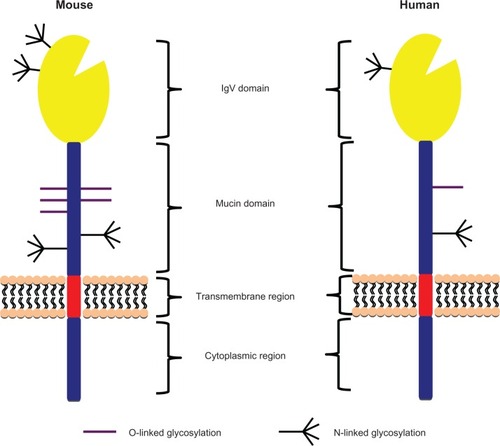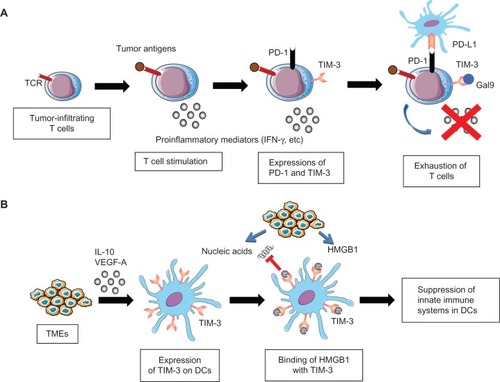Figures & data
Figure 1 Schema of human and mouse T cell immunoglobulin domain and mucin domain-3 (TIM-3) protein structures. TIM-3 consists of an N-terminal immunoglobulin (Ig) V domain followed by a mucin domain, transmembrane region, and a cytoplasmic region. The IgV and mucin domains contain O- and N-linked glycosylation sites.

Figure 2 Role of T cell immunoglobulin domain and mucin domain-3 (TIM-3) in cancer immunosuppression.
Notes: (A) Exhaustion of T cells by TIM-3 and programmed cell death protein 1 (PD-1). Tumor-infiltrating T cells secrete interferon-γ (IFNγ) upon binding of tumor antigens by T cell receptors (TCR). However, TIM-3 and PD-1 are upregulated on tumor-infiltrating T cells upon chronic exposure to antigenic stimuli, and interact with galectin-9 (Gal9) and programmed cell death 1 ligand 1 (PD-L1) expressed on tumors or tumor-infiltrating stromal cells. These interactions impair the effector activities of tumor-infiltrating T cells, leading to cancer immunosuppression. (B) Immunosuppression of dendritic cells (DCs) by TIM-3. TIM-3 expression on DCs is induced via stimulation by interleukin (IL) 10 and vascular endothelial growth factor A (VEGF-A), which are mainly secreted from tumor microenvironments (TMEs). TIM-3 on DCs binds high mobility group box 1 (HMGB1) from inflammatory TMEs, and negatively regulates the HMGB1-mediated recruitment of TMR-derived nucleic acids, thereby suppressing the innate immune systems. As a result, TIM-3 on DCs enables tumors to acquire immunosuppressive capabilities.
